Shenmue theme by Emre
Download: Shenmue.p3t
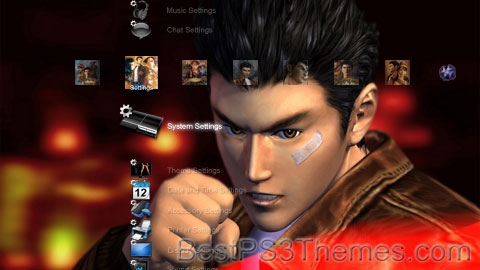
(7 backgrounds, HD only)
| Shenmue | |
|---|---|
 | |
| Genre(s) | Action-adventure Interactive cinema Life simulation Social simulation |
| Developer(s) |
|
| Publisher(s) | |
| Creator(s) | Yu Suzuki |
| Platform(s) | |
| First release | Shenmue December 29, 1999 |
| Latest release | Shenmue III November 19, 2019 |
Shenmue[a] is an action-adventure game series created, produced and directed by Yu Suzuki. Shenmue (1999) and Shenmue II (2001) were developed by Sega AM2 and published by Sega for the Dreamcast. Shenmue III, developed by Suzuki's company Ys Net, was released for the PlayStation 4 and Windows in 2019.
The Shenmue games consist of open-world 3D environments interspersed with brawler battles and quick time events. They include elements of role-playing, life simulation and social simulation games, such as a day-and-night system, variable weather effects, non-player characters with daily schedules and interactive elements, such as vending machines, arcades, and minigames. The story follows the teenage martial artist Ryo Hazuki as he travels through 1980s Japan and China in pursuit of his father's killer. The original Shenmue was the most expensive video game ever developed at the time, with an estimated production and marketing cost of US$47 to $70 million, though some of the development also covered Shenmue II.
Shenmue and Shenmue II received mostly positive reviews. Critics praised their graphics, soundtrack, realism and ambition, but criticized their controls, slow pace and voice acting, and the focus on mundane detail divided players. The games attracted a cult following, appearing in several lists of the greatest video games of all time, and are credited for pioneering game systems, including quick time events and open worlds. However, they were commercial failures and further installments entered development hell.
In 2004, Sega announced a spin-off massively multiplayer online role-playing game, Shenmue Online, but it was not released. In 2010, a social game, Shenmue City, was launched in Japan; it was shut down a year later. In 2018, Sega released high-definition ports of Shenmue and Shenmue II for multiple formats. Following a successful crowdfunding campaign, Suzuki developed Shenmue III independently. It was released for the PlayStation 4 and Windows in 2019, and received mixed reviews for its similarity to the earlier games. An anime adaptation of Shenmue, co-produced by Crunchyroll and Adult Swim, premiered in February 2022.
Gameplay[edit]
In the Shenmue games, the player controls the teenage martial arts pupil Ryo Hazuki as he investigates his father's murder. The player explores the Yokosuka, Hong Kong and Guilin open worlds, searching for clues, examining objects and talking to non-player characters for information. The games feature a 3D fighting system similar to Sega's Virtua Fighter series; Ryo can fight multiple opponents at once, and can practice moves to increase their power. In quick time events, the player must press the right combination of buttons at the right moment to succeed.[1][2]
Shenmue I and Shenmue II feature a level of detail considered unprecedented for games at the time of their release.[3] Shops open and close, buses run to timetables, and characters have their own routines, each in accordance with the game's persistent clock.[4][5] Ryo receives a daily allowance which can be spent on objects including food, raffle tickets, audio cassettes and capsule toys. There are several minigames; for example, Ryo can throw darts or play complete versions of Sega arcade games, or earn money from minigames including driving forklift trucks, gambling, arm wrestling, fishing and street fighting.[6][7][8] The Dreamcast version of Shenmue II allows the player to import their save data from Shenmue, carrying over money, inventory items and martial arts moves.[7]
Premise[edit]
Games[edit]
| 1999 | Shenmue |
|---|---|
| 2000 | |
| 2001 | Shenmue II |
| 2002 | |
| 2003 | |
| 2004 | |
| 2005 | |
| 2006 | |
| 2007 | |
| 2008 | |
| 2009 | |
| 2010 | Shenmue City |
| 2011 | |
| 2012 | |
| 2013 | |
| 2014 | |
| 2015 | |
| 2016 | |
| 2017 | |
| 2018 | Shenmue I & II |
| 2019 | Shenmue III |
IGN described Shenmue as a "revenge epic in the tradition of Chinese cinema".[9] According to Suzuki, the three games cover around 40% of the story he has planned.[10]
Main series[edit]
Shenmue[edit]
In 1986 Yokosuka, Japan, the teenage martial artist Ryo Hazuki returns to his family dojo to witness a confrontation between his father Iwao and a Chinese man, Lan Di. Lan Di demands Iwao give him a mysterious stone artifact, the dragon mirror. When he threatens to kill Ryo, Iwao tells him the mirror is buried under the cherry blossom tree outside. As Lan Di's men dig up the mirror, Lan Di mentions Zhao Sunming, whom Iwao allegedly killed in Mengcun, China. Lan Di delivers a finishing blow and Iwao dies in Ryo's arms.
Ryo's investigation leads him to Master Chen in the Yokosuka harbor. Through Chen and his son Guizhang, Ryo learns that the dragon mirror taken by Lan Di is one of two mirrors. He locates the second, the phoenix mirror, in a basement hidden beneath his father's dojo. He defeats a local gang connected to Lan Di's organization, and Master Chen tells him to seek the aid of Master Xiuying in Hong Kong. Ryo boards a boat to China.
Shenmue II[edit]
In Hong Kong, Ryo finds Master Xiuying Hong, but she refuses to help him, considering his quest for vengeance reckless. Ryo teams up with a gang leader, Wuying Ren, a free-spirited motorcyclist, Joy, and a street boy, Wong, to find Yuanda Zhu, who sent Ryo's father a letter warning him of Lan Di's intentions.
Ryo and his allies locate Zhu in Kowloon Walled City, but are ambushed by the criminal Yellow Head organization and Zhu is kidnapped. Ryo rescues Zhu as Lan Di departs by helicopter. Zhu reveals that Lan Di killed Ryo's father because he believes Iwao killed his own father. Zhu also reveals that the mirrors will lead to the resurrection of the Qing Dynasty, the last imperial dynasty of China. Zhu advises Ryo to continue his search in the village of Bailu in Guilin, where Lan Di is also heading.
In Guilin, Ryo meets a teenage girl, Shenhua Ling, whose family is connected to the legacy of the dragon and phoenix mirrors. She leads Ryo to a stone quarry on the village outskirts to meet her father, but discovers he is missing.
Shenmue III[edit]
Ryo learns that Lan Di's father, Zhao Sunming, once visited Bailu with Ryo's father to train under the local grandmaster. Zhao died under mysterious circumstances several years later. Ryo also discovers that the phoenix and dragon mirrors were created by Shenhua's great-grandfather at the request of the Chinese emperor.
Ryo and Shenhua learn that Shenhua's father, Yuan, has been kidnapped by a local gang looking for the phoenix mirror. Ryo defeats two of the thugs, but is defeated by their boss, Yanlang. He convinces Sun, a local martial arts master, to teach him a powerful Bajiquan move, and uses it to defeat Yanlang. A village elder helps them discover a map to the treasure connected to the mirrors. Ryo fends off an attack from Chai, who reveals that Yuan and Xu have been taken to the city of Niaowu.
In Niaowu, Ryo and Shenhua learn that a local gang, the Red Snakes, is holding Yuan and Xu hostage. Shenhua is tricked by a Chi You Men leader, Niao Sun. Ryo and his allies infiltrate the Chi You Men's castle and rescue Shenhua and her father. Ryo confronts Lan Di, but Lan Di easily defeats him. Niao Sun betrays Lan Di, and has her men burn the castle. Ryo, Ren and Shenhua continue their journey along the Great Wall of China.
Development[edit]

Shenmue and Shenmue II[edit]
The creator of Shenmue, Yu Suzuki, joined Sega in 1983 and created several successful arcade games, including Hang-On (1985), Out Run (1986) and Virtua Fighter (1993).[11] In comparison to arcade games, where the ideal experience was only a few minutes long, Suzuki wanted to make a longer experience.[11] In 1996, he and Sega AM2 began developing a Saturn RPG based on the Virtua Fighter series.[11]
In 1997, development moved to Sega's upcoming console, the Dreamcast,[12] and the Virtua Fighter connection was dropped.[12] By the time of the Dreamcast's release in Japan in November 1998, the game had been titled Shenmue.[11] Sega advertised Shenmue as belonging to a new genre it termed "full reactive eyes entertainment" or "FREE".[13] It became the most expensive game ever developed at the time, reported to have cost US$70 million; in 2011, Suzuki said the figure was closer to $47 million including marketing.[1] The development also covered some of Shenmue II (2001), which was completed for a smaller figure,[14] and possibly groundwork for future Shenmue games.[15]
Shenmue was released on December 29, 1999 in Japan,[16] November 8, 2000 in North America,[17] and December 1, 2000 in Europe.[18] Shenmue II was released for Dreamcast in 2001 in Japan and Europe only. An Xbox port followed in 2002 in Japan, Europe and North America. Despite attracting positive reviews and a cult following, neither game made a profit and Shenmue III entered development hell.[19]
Shenmue Online and Shenmue City[edit]
Suzuki worked on various projects which failed to see release,[20] including Shenmue Online, a PC MMORPG announced in 2004.[21][22][23] He established his own development company, Ys Net, in 2008[20] and left Sega in 2011.[20] In 2010, Sega announced Shenmue City, a social game for the Mobage service.[24] It was not released outside Japan and was shut down in December 2011.[25]
Shenmue III and remasters[edit]
During Sony's presentation at the E3 conference on June 15, 2015, Suzuki announced a Kickstarter crowdfunding campaign for Shenmue III, having licensed the series from Sega. Shenmue III became the fastest-funded and the highest-funded video game project in Kickstarter history, reaching its initial $2 million goal in just over nine hours,[26] and earning $6.3 million in total.[27] It was released on 19 November 2019 for PlayStation 4 and Windows.[28]
Sega began developing remasters of Shenmue I and II featuring new models, textures and lighting, but it was canceled in 2017. Sega said that "working with original animations and characters but meshing them with enhanced HD visuals gave us a game that we felt would not meet the standards that Shenmue fans expect and deserve".[29] Instead, in August 2018, Sega released high-definition ports for Windows, PlayStation 4 and Xbox One.[30] The ports include new graphics and control options, improved user interfaces, and Japanese and English voices.[31] Some details, such as product placement, are omitted, and cutscenes are presented in their original aspect ratio due to technical limitations.[32]
Later projects[edit]
In 2015, Suzuki said he hoped the series would cover four or five games.[33] Shenmue III includes a letter to fans from Suzuki expressing his hope to develop Shenmue IV.[34] In 2020, Suzuki told IGN he had created Shenmue III "for the fans", and that he planned to give Shenmue IV more mainstream appeal.[35]
Reception[edit]
| Game | Metacritic |
|---|---|
| Shenmue | (DC) 89%[36][b] |
| Shenmue II | (DC) 88/100[37] (Xbox) 80/100[38] |
| Shenmue III | (PC) 69/100[39] (PS4) 67/100[40] |
The Shenmue series has received mostly positive reviews and has attracted a cult following, with Shenmue I and II appearing in several "greatest video games of all time" lists.[41][42][43] Shenmue III, released almost two decades later, received mixed reviews for its similarity to the earlier games. Some critics described it as outdated, while others praised its faithfulness to the franchise.[44] The series has received praise for its graphics, soundtrack, realism and ambition, but criticism for its controls, slow pace and voice acting; its realism and focus on mundane detail has divided players.[45][46]
Shenmue is credited for pioneering several game technologies. Its large environments, wealth of options and level of detail have been compared to later open-world games including the Grand Theft Auto series, the Yakuza series, Fallout 3 (2008), and Deadly Premonition (2010).[47][48][49][50] Shenmue is also credited for naming and popularizing the quick time event in modern games,[51][52] which was featured in the Resident Evil, God of War, and Tomb Raider series.[53]
Music[edit]
Several Shenmue soundtracks have been released. A promotional album, Shenmue Juke Box, was packaged with the limited edition of the original game in Japan and North America, containing ten select tracks from the in-game cassette tapes.[54]
A soundtrack for the first game, Shenmue OST: Chapter 1: Yokosuka, was released in 2000.[55] In September 2015, Data Discs released the Shenmue soundtrack on vinyl in three separate colored editions.[56] In March 2016, the music of Shenmue was voted into the Classic FM Hall of Fame in 144th place.[57]
Television series[edit]
An anime adaptation of Shenmue was announced on September 4, 2020, at the virtual Crunchyroll Expo.[58] It premiered on simultaneously on February 6, 2022, on the U.S. network Adult Swim's Toonami programming block and the streaming platform Crunchyroll in English dub and Japanese sub, respectively.[59] The series is directed by Sakurai Chikara, with Suzuki as executive producer, and adapts the events of the first two games. It was animated by Telecom Animation Film, with production management by Sola Entertainment.[59]
Other appearances[edit]
Ryo Hazuki is a playable character in Sega's mascot racer Sonic & Sega All-Stars Racing. Ryo rides Naoyuki's motorbike and his special move features him driving a forklift, referencing his job at the Yokosuka Harbor.[60] A second version of Ryo that only rides the forklift was released as downloadable content.[61][62]
In 2012, Steve Lycett, executive producer of Sumo Digital, encouraged a fan-made poll on the Sega forums to determine which three Sega characters the fans would like to see in Sonic & All-Stars Racing Transformed as downloadable content (DLC). Out of the 28 Sega characters chosen by the forum, Ryo Hazuki had the majority vote ranking 1st, while Hatsune Miku ranked 2nd, and Segata Sanshiro ranked 3rd.[63] On January 1, 2014, SEGA announced that Ryo will appear in the iOS and Android versions of Sonic & All Stars Racing Transformed which was released on January 2.[64] On January 14, Ryo became available for purchase as DLC on Steam for the PC version of Sonic and All Stars Racing Transformed. In this game, Ryo rides an arcade-themed vehicle that switches between OutRun, Hang-On, and Space Harrier arcade cabinets depending on its form.[65]
Notes[edit]
- ^ Japanese: シェンムー, Hepburn: Shenmū
- ^ GameRankings score
References[edit]
- ^ a b Diver, Mike (May 2, 2014). "Shenmue – discovering the Sega classic 14 years too late". the Guardian. Archived from the original on June 26, 2015. Retrieved June 30, 2015.
- ^ "Why is everybody so excited? WHAT'S A SHENMUE?". June 25, 2015. Archived from the original on March 3, 2016. Retrieved June 30, 2015.
- ^ "'90s Making of Shenmue documentary gives glimpse into legendary game". www.gameskinny.com. Archived from the original on September 22, 2016. Retrieved November 19, 2015.
- ^ "Shenmue once featured cats that walk on two legs". Eurogamer. March 19, 2014. Archived from the original on October 1, 2015. Retrieved June 29, 2015.
- ^ "Shenmue Review | Edge Online". Edge. May 31, 2013. Archived from the original on May 31, 2013. Retrieved July 3, 2015.
- ^ "Shenmue II Review". GameSpot. Archived from the original on January 9, 2016. Retrieved November 20, 2015.
COD5 Swamp Zombie
COD5 Swamp Zombie theme by Pacinolife(Background)+Chill/Warmachine(Icons)
Download: COD5SwampZombie.p3t
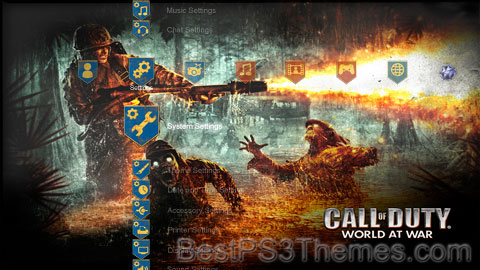
(1 background)
P3T Unpacker v0.12
Copyright (c) 2007. Anoop MenonThis program unpacks Playstation 3 Theme files (.p3t) so that you can touch-up an existing theme to your likings or use a certain wallpaper from it (as many themes have multiple). But remember, if you use content from another theme and release it, be sure to give credit!
Download for Windows: p3textractor.zip
Instructions:
Download p3textractor.zip from above. Extract the files to a folder with a program such as WinZip or WinRAR. Now there are multiple ways to extract the theme.
The first way is to simply open the p3t file with p3textractor.exe. If you don’t know how to do this, right click the p3t file and select Open With. Alternatively, open the p3t file and it will ask you to select a program to open with. Click Browse and find p3textractor.exe from where you previously extracted it to. It will open CMD and extract the theme to extracted.[filename]. After that, all you need to do for any future p3t files is open them and it will extract.
The second way is very simple. Just drag the p3t file to p3textractor.exe. It will open CMD and extract the theme to extracted.[filename].
For the third way, first put the p3t file you want to extract into the same folder as p3textractor.exe. Open CMD and browse to the folder with p3extractor.exe. Enter the following:
p3textractor filename.p3t [destination path]Replace filename with the name of the p3t file, and replace [destination path] with the name of the folder you want the files to be extracted to. A destination path is not required. By default it will extract to extracted.filename.Mortal Kombat #2
Mortal Kombat theme by monomania247
Download: MortalKombat_2.p3t
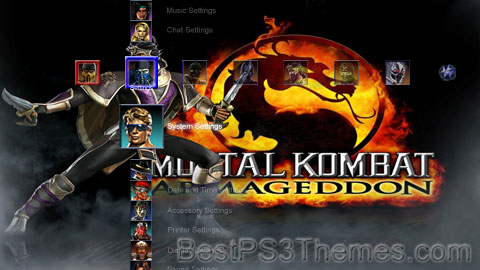
(16 backgrounds, HD only)
Mortal Kombat 
Genre(s) Fighting
Action-adventureDeveloper(s) Publisher(s) - Midway Games
- Williams Entertainment
- Warner Bros. Games
Creator(s) Platform(s) List- Amiga
Android
Arcade
Dreamcast
Game Boy
Game Boy Advance
Game Boy Color
GameCube
Game Gear
Game.com
iOS
Windows
Master System
MS-DOS
Nintendo 64
Nintendo DS
Nintendo Switch
PlayStation
PlayStation 2
PlayStation 3
PlayStation 4
PlayStation 5
PlayStation Portable
PlayStation Vita
R-Zone
32X
Sega CD
Sega Genesis
Sega Saturn
Super NES
Stadia
TV game
Wii
Xbox
Xbox 360
Xbox One
Xbox Series X/S
First release Mortal Kombat
August 1992; 31 years agoLatest release Mortal Kombat 1
September 19, 2023Mortal Kombat is an American media franchise centered on a series of fighting video games originally developed by Midway Games in 1992.
The original Mortal Kombat arcade game spawned a franchise consisting of action-adventure games, a comic book series, a card game, films, an animated TV series, and a live-action tour. Mortal Kombat has become the best-selling fighting game franchise worldwide and one of the highest-grossing media franchises of all time.
The series has a reputation for high levels of graphic violence, including, most notably, its fatalities, which are finishing moves that kill defeated opponents instead of knocking them out. Controversies surrounding Mortal Kombat, in part, led to the creation of the Entertainment Software Rating Board (ESRB) video game rating system. Early games in the series were noted for their realistic digitized sprites and an extensive use of palette swapping to create new characters. Following Midway's bankruptcy, the Mortal Kombat development team was acquired by Warner Bros. Entertainment and re-established as NetherRealm Studios.
Gameplay[edit]

Mortal Kombat II arcade cabinet's control board The original three games and their updates, Mortal Kombat (1992), Mortal Kombat II (1993), Mortal Kombat 3 (1995), Ultimate Mortal Kombat 3 (1995), and Mortal Kombat Trilogy (1996), are 2D fighting games. The arcade cabinet versions of the first two used a joystick and five buttons: high punch, low punch, high kick, low kick, and block; Mortal Kombat 3 and its updates added a sixth "run" button.[1] Characters in the early Mortal Kombat games play virtually identically to one another, with the only major differences being their special moves.[2] Through the 1990s, the developer and publisher Midway Games kept their single-styled fighting moves with four attack buttons for a different array of punches, kicks and blocks. Mortal Kombat 4 was the first Mortal Kombat game in which the characters could move in three dimensions and the first to use 3D computer graphics. From Deadly Alliance to Mortal Kombat: Deception, characters had three fighting styles per character: two unarmed styles, and one weapon style.[3] While most of the styles used in the series are based on real martial arts, some are fictitious.[4] Goro's fighting styles, for example, are designed to take advantage of the fact that he has four arms. For Armageddon, fighting styles were reduced to a maximum of two per character (generally one hand-to-hand combat style and one weapon style) due to the sheer number of playable characters.[5] Mortal Kombat vs. DC Universe dropped multiple fighting styles for most characters in favor of giving each character a wider variety of special moves[6][7] 2011's Mortal Kombat returned to a single 2D fighting plane, although characters are rendered in 3D;[8] unlike previous Mortal Kombat games, each of the controller's four attack buttons corresponds to one of the character's limbs, the buttons thus becoming front punch, back punch, front kick and back kick ("front" indicates the limb that is closer to the opponent, and "back" indicates the limb that is farther away from the opponent).
Mortal Kombat: Deception and Mortal Kombat: Armageddon feature "Konquest", a free-roaming action-adventure mode. Both games include distinct minigame modes such as "Chess Kombat", an action-strategy game. Two other bonus minigames, "Puzzle Kombat" inspired by Puzzle Fighter and "Motor Kombat" inspired by Mario Kart, feature super deformed versions of Mortal Kombat characters.[1] The games contain various unlockable content and hidden cheats.[9]
Finishing moves[edit]
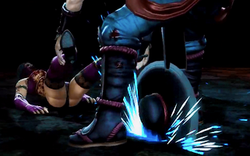
Kung Lao's "Razor's Edge" Fatality being performed on Mileena in 2011's Mortal Kombat. NetherRealm Studios' Ed Boon described it as possibly the most painful-looking finishing move in the series yet[10] I think [Mortal Kombat] represents the difference in philosophy. [....] So in Street Fighter when you're playing it's the moment to moment gameplay that should be the best, whether you win or lose doesn't really matter. Whereas in Mortal Kombat the fighting and playing is just a pathway to get to the result – it's the Fatality you want to see and you almost want to skip the fighting bit and get to the Fatality because that is the result.[11]
—Street Fighter producer Yoshinori Ono
One of the most notable features of the Mortal Kombat series is its brutal and gruesome finishing moves, known as "Fatalities". The basic Fatalities are finishing moves that allow the victorious characters to end a match by murdering their defeated, defenseless opponent.[12] Usually Fatalities are exclusive to each character, the exception being Mortal Kombat: Armageddon, which instead features Kreate-A-Fatality, a feature that allows players to perform their own Fatalities by conducting a series of violent moves chosen from a pool that is common to all characters.[1][13]
Other finishing moves in the various Mortal Kombat games include Animalities (introduced in Mortal Kombat 3), in which the victor turns into an animal to violently finish off the opponent;[14] Brutality (introduced in Ultimate Mortal Kombat 3) which consists of bashing the opponent into pieces with a long combo of hits; and Stage Fatalities/Death Traps (introduced in the original Mortal Kombat Pit Stage where the victor can uppercut their opponent off of the platform into a bed of spikes below, later made more difficult in Mortal Kombat II by requiring a character-specific button sequence) utilizing parts of certain stages to execute a lethal finishing move (such as a pool of acid). Mortal Kombat: Deception added the Hara-Kiri, a move that allows the loser to perform a suicidal finishing move, giving way to a potential race between both players to see if the winner can finish off their opponent before they can kill themselves.[12][15]
There are two non-violent finishing moves in the series, which were introduced in Mortal Kombat II as a satire to controversies surrounding Mortal Kombat:[12] Friendship moves, which result in a display of friendship towards the enemy instead of slaughter,[16] and Babalities, which turn the opponent into a baby.[16][14]
Plot[edit]
The series takes place in a fictional universe consisting of numerous realms which, according to in-game backstories, were created by an ancient, eternal, and ethereal pantheon of preternatural divine beings known as the Elder Gods. The Mortal Kombat: Deception manual described six of the realms as: "Earthrealm, home to such legendary heroes as Liu Kang, Kung Lao, Sonya Blade, Johnny Cage, and Jax Briggs, and under the protection of the Thunder God Raiden; Netherrealm, the fiery depths of which are inhospitable to all but the most vile, a realm of demons and shadowy warriors such as Quan Chi and Noob Saibot; Outworld, a realm of constant strife which Emperor Shao Kahn claims as his own; Seido, the Realm of Order, whose inhabitants prize structure and order above all else; the Realm of Chaos, whose inhabitants do not abide by any rules whatsoever, and where constant turmoil and change are worshiped; and Edenia, which is known for its beauty, artistic expression, and the longevity of its inhabitants."[17][18] The Elder Gods decreed that the denizens of one realm could only conquer another realm by defeating the defending realm's greatest warriors in ten consecutive martial arts tournaments, called Mortal Kombat.
The first Mortal Kombat game takes place in Earthrealm (Earth) where seven different warriors with their own reasons for entering the tournament with the prize being the continued freedom of their realm under threat of a takeover by Outworld. Among the established warriors were Liu Kang, Johnny Cage, and Sonya Blade. With the help of the thunder god Raiden, the Earthrealm warriors were victorious, and Liu Kang became the new champion of Mortal Kombat.[19] In Mortal Kombat II, unable to deal with his minion Shang Tsung's failure, Outworld Emperor Shao Kahn lures the Earthrealm warriors to Outworld for a do-over, winner-take-all tournament, where Liu Kang eventually defeats Shao Kahn. By the time of Mortal Kombat 3, Shao Kahn merged Edenia with his empire and revived its former queen Sindel in Earthrealm, combining it with Outworld as well. He attempts to invade Earthrealm, but is ultimately defeated by Liu Kang once more. After the Kahn's defeat, Edenia was freed from his grasp and returned to a peaceful realm, ruled by Princess Kitana. The following game, Mortal Kombat 4, features the fallen elder god Shinnok attempting to conquer the realms and kill Raiden. He is defeated by Liu Kang.
In Mortal Kombat: Deadly Alliance, the evil sorcerers Quan Chi and Shang Tsung join forces to conquer the realms, killing series protagonist Liu Kang in the process. By Mortal Kombat: Deception, after several fights, the sorcerers emerge victorious, having killed most of Earthrealm's warriors until Raiden steps forth to oppose them. The Dragon King Onaga, former ruler of Outworld, returned to merge all realms back together, but was eventually defeated by the game's protagonist, Shujinko.[20]
In Mortal Kombat: Armageddon, the titular catastrophe begins. Centuries before the first Mortal Kombat, Queen Delia foretold the realms would be destroyed because the power of all of the realms' warriors would rise to such greatness that it would overwhelm and destabilize the realms, triggering a destructive chain of events. King Argus had his sons, Taven and Daegon, put into incubation so one day they can be awakened to save the realms from Armageddon by defeating a firespawn known as Blaze. In the end, Shao Kahn is the one who defeats Blaze and wins the war, causing Armageddon.[21]
The crossover Mortal Kombat vs. DC Universe does not share continuity with the other games. After the simultaneous defeats of both Shao Kahn and the alien warlord Darkseid in the DC Universe causes both villains to fuse into the entity "Dark Kahn", both the Mortal Kombat and DC Universes begin to merge. This brings the warriors and heroes into conflicts after suffering bouts of uncontrollable rage. The heroes and villains of both universes repeatedly battle each other, believing each other to be responsible for the catastrophe, until only Raiden and Superman remain. The two confront Dark Kahn and team up to defeat their common foe. After Dark Kahn's defeat, the two realms defuse, with Shao Kahn and Darkseid trapped in each other's universes to face eternal imprisonment.
In the 2011 Mortal Kombat soft reboot, the battle of Armageddon culminated in only two survivors: Shao Kahn and Raiden. On the verge of death by the former's hand, the latter sent visions to his past self in a last-ditch attempt to prevent this outcome. Upon receiving the visions, the past Raiden attempts to alter the timeline to avert Armageddon amidst the tenth Mortal Kombat tournament, during the original game. His attempts to alter history mean that events play out differently to the original series. While he succeeds in preventing Shao Kahn's victory with help from the Elder Gods, he accidentally kills Liu Kang in self-defense and loses most of his allies to Queen Sindel, leaving Earthrealm vulnerable to Shinnok and Quan Chi's machinations.
Mortal Kombat X sees Shinnok and Quan Chi enacting their plan, leading an army of undead revenants of those that were killed in Shao Kahn's invasion of Earthrealm. A team of warriors led by Raiden, Johnny Cage, Kenshi Takahashi, and Sonya Blade oppose them, and in the ensuing battle, Shinnok is imprisoned within his amulet and various warriors are resurrected and freed from his control, though Quan Chi escapes. Twenty-five years later, the sorcerer resurfaces alongside the insectoid D'Vorah to facilitate Shinnok's return. A vengeful Scorpion kills Quan Chi, but fails to stop him from freeing Shinnok. To combat him, Cassie Cage, daughter of Johnny Cage and Sonya Blade, leads a team composed of the next generation of Earthrealm's heroes in defeating him. With Shinnok and Quan Chi defeated, Liu Kang and Kitana's revenants assume control of the Netherrealm while Raiden taps into Shinnok's amulet.
Mortal Kombat 11 and its expansion, Aftermath, sees the architect of time and Shinnok's mother, Kronika, working to alter the timeline following her son's defeat and Raiden's tampering with her work. In doing so, she brings past versions of the realm's heroes to the present, aligning herself with some while the rest work to defeat her. After nearly killing Liu Kang a second time, Raiden discovers Kronika has manipulated them into fighting across multiple timelines as she fears their combined power. Despite her interference and attacks by her minions, Raiden gives Liu Kang his power, turning him into a god of fire and thunder so he can defeat Kronika. In the Aftermath expansion, it is revealed that Liu Kang inadvertently destroyed Kronika's crown, the item needed to restart the timeline. Her defeat also revives Shang Tsung, who was absent in the base game due to his imprisonment by Kronika. To recover the crown, Liu Kang sends Shang Tsung and other Earthrealm heroes back in time to obtain it before Kronika, though Shang Tsung manipulates events so that he comes into possession of the crown. At the end, either Liu Kang or Shang Tsung becomes the Keeper of Time, depending on the player's choice (who they want to fight with in the final battle) and the outcome of the battle.
Mortal Kombat 1, the second reboot on the series' timeline, sees Lord Liu Kang has created his New Era and strives to maintain peace between all the realms. However, his plans begin to unravel when Shang Tsung and Quan Chi, despite his attempts to have them de-powered and unable to cause trouble, ally with General Shao in order to conquer Earthrealm and Outworld. Investigating the matter, Liu Kang discovers that the Shang Tsung from MK11: Aftermath is responsible, as Liu Kang's attempts to access the Hourglass' power resulted in a break where every character in Mortal Kombat's universe defeated Kronika and gained control of the Hourglass. In an attempt to stop the sorcerer from taking control of all of the multiple timelines, Liu Kang leads an army of good variations in an assault on Titan Shang Tsung's dimension, where, after an intense battle with all their evil counterparts, Liu Kang and a player-decided champion defeat him and erase his timeline from existence.
Characters[edit]

Cosplayers of Kitana, Reptile, and Sonya Blade at Dragon Con 2012 Through its iterations, the series has featured scores of player characters, some of them becoming mainstays, such as Baraka, Cassie Cage, Cyrax, Ermac, Fujin, Goro, Jade, Jax, Johnny Cage, Kabal, Kano, Kenshi, Kintaro, Kitana, Kung Lao, Li Mei, Liu Kang, Mileena, Motaro, Nightwolf, Noob Saibot, Quan Chi, Raiden, Rain, Reptile, Scorpion, Sektor, Shang Tsung, Shao Kahn, Sheeva, Shinnok, Sindel, Skarlet, Smoke, Sonya Blade, Stryker, Sub-Zero and Tanya. Among them are Earth's humans and cyborgs, good and evil deities, and denizens of Outworld and other realms.
Starting with Mortal Kombat vs. DC Universe, which featured several DC Universe heroes and villains, all subsequent games have included guest characters such as Freddy Krueger from A Nightmare on Elm Street franchise, Kratos from the God of War franchise (exclusively for PlayStation 3), Jason Voorhees from the Friday the 13th franchise, the Xenomorph from Alien, Leatherface from the Texas Chainsaw Massacre franchise, the titular character of Predator, the titular character of the Terminator franchise, the titular character of RoboCop, Spawn of Image Comics, Omni-Man from Image Comics's Invincible, John Rambo, Homelander from The Boys, and the Joker, who was previously in Mortal Kombat vs. DC Universe, and Peacemaker (more specifically: the character from the DC Extended Universe and DC Universe), both from DC Comics.[citation needed]
Development[edit]
Release timeline Main series in bold1992 Mortal Kombat 1993 Mortal Kombat II 1994 1995 Mortal Kombat 3 Ultimate Mortal Kombat 3 1996 Mortal Kombat Trilogy 1997 Mortal Kombat Mythologies: Sub-Zero Mortal Kombat 4 1998 1999 Mortal Kombat Gold 2000 Mortal Kombat: Special Forces 2001 Mortal Kombat Advance 2002 Mortal Kombat: Deadly Alliance 2003 Mortal Kombat: Tournament Edition 2004 Mortal Kombat: Deception 2005 Mortal Kombat: Shaolin Monks 2006 Mortal Kombat: Armageddon Mortal Kombat: Unchained 2007 Ultimate Mortal Kombat 2008 Mortal Kombat vs. DC Universe 2009–2010 2011 Mortal Kombat Mortal Kombat Arcade Kollection 2012 Mortal Kombat: Komplete Edition 2013–2014 2015 Mortal Kombat X Mortal Kombat Mobile 2016 Mortal Kombat XL 2017–2018 2019 Mortal Kombat 11 2020 Mortal Kombat 11: Aftermath Mortal Kombat 11: Ultimate 2021 2022 Mortal Kombat: Onslaught 2023 Mortal Kombat 1 Origins[edit]
Mortal Kombat started development in 1991 with four people: Ed Boon (programming), John Tobias (art and story), John Vogel (graphics), and Dan Forden (sound design).[22][23] According to Mortal Kombat actors Richard Divizio and
ThaLastHero’s Theme
ThaLastHero’s Theme by ThaLastHero
Download: ThaLastHerosTheme.p3t
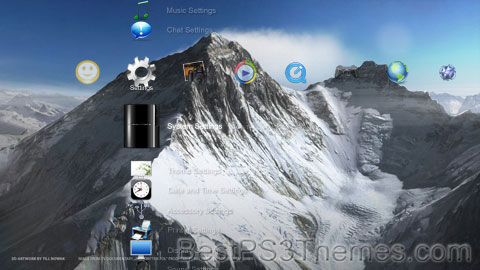
(9 backgrounds, HD only)
P3T Unpacker v0.12
Copyright (c) 2007. Anoop MenonThis program unpacks Playstation 3 Theme files (.p3t) so that you can touch-up an existing theme to your likings or use a certain wallpaper from it (as many themes have multiple). But remember, if you use content from another theme and release it, be sure to give credit!
Download for Windows: p3textractor.zip
Instructions:
Download p3textractor.zip from above. Extract the files to a folder with a program such as WinZip or WinRAR. Now there are multiple ways to extract the theme.
The first way is to simply open the p3t file with p3textractor.exe. If you don’t know how to do this, right click the p3t file and select Open With. Alternatively, open the p3t file and it will ask you to select a program to open with. Click Browse and find p3textractor.exe from where you previously extracted it to. It will open CMD and extract the theme to extracted.[filename]. After that, all you need to do for any future p3t files is open them and it will extract.
The second way is very simple. Just drag the p3t file to p3textractor.exe. It will open CMD and extract the theme to extracted.[filename].
For the third way, first put the p3t file you want to extract into the same folder as p3textractor.exe. Open CMD and browse to the folder with p3extractor.exe. Enter the following:
p3textractor filename.p3t [destination path]Replace filename with the name of the p3t file, and replace [destination path] with the name of the folder you want the files to be extracted to. A destination path is not required. By default it will extract to extracted.filename.D_A_R_K_x_X
D_A_R_K_x_X theme by zed
Download: DARKxX.p3t
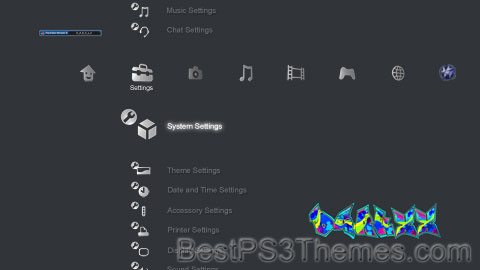
(3 backgrounds)
P3T Unpacker v0.12
Copyright (c) 2007. Anoop MenonThis program unpacks Playstation 3 Theme files (.p3t) so that you can touch-up an existing theme to your likings or use a certain wallpaper from it (as many themes have multiple). But remember, if you use content from another theme and release it, be sure to give credit!
Download for Windows: p3textractor.zip
Instructions:
Download p3textractor.zip from above. Extract the files to a folder with a program such as WinZip or WinRAR. Now there are multiple ways to extract the theme.
The first way is to simply open the p3t file with p3textractor.exe. If you don’t know how to do this, right click the p3t file and select Open With. Alternatively, open the p3t file and it will ask you to select a program to open with. Click Browse and find p3textractor.exe from where you previously extracted it to. It will open CMD and extract the theme to extracted.[filename]. After that, all you need to do for any future p3t files is open them and it will extract.
The second way is very simple. Just drag the p3t file to p3textractor.exe. It will open CMD and extract the theme to extracted.[filename].
For the third way, first put the p3t file you want to extract into the same folder as p3textractor.exe. Open CMD and browse to the folder with p3extractor.exe. Enter the following:
p3textractor filename.p3t [destination path]Replace filename with the name of the p3t file, and replace [destination path] with the name of the folder you want the files to be extracted to. A destination path is not required. By default it will extract to extracted.filename.Ghost-Dreamer
Ghost-Dreamer theme by Jetice
Download: Ghost-Dreamer.p3t
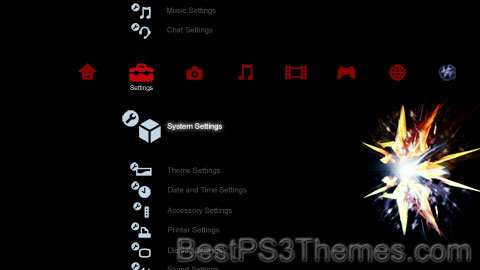
(1 background)
P3T Unpacker v0.12
Copyright (c) 2007. Anoop MenonThis program unpacks Playstation 3 Theme files (.p3t) so that you can touch-up an existing theme to your likings or use a certain wallpaper from it (as many themes have multiple). But remember, if you use content from another theme and release it, be sure to give credit!
Download for Windows: p3textractor.zip
Instructions:
Download p3textractor.zip from above. Extract the files to a folder with a program such as WinZip or WinRAR. Now there are multiple ways to extract the theme.
The first way is to simply open the p3t file with p3textractor.exe. If you don’t know how to do this, right click the p3t file and select Open With. Alternatively, open the p3t file and it will ask you to select a program to open with. Click Browse and find p3textractor.exe from where you previously extracted it to. It will open CMD and extract the theme to extracted.[filename]. After that, all you need to do for any future p3t files is open them and it will extract.
The second way is very simple. Just drag the p3t file to p3textractor.exe. It will open CMD and extract the theme to extracted.[filename].
For the third way, first put the p3t file you want to extract into the same folder as p3textractor.exe. Open CMD and browse to the folder with p3extractor.exe. Enter the following:
p3textractor filename.p3t [destination path]Replace filename with the name of the p3t file, and replace [destination path] with the name of the folder you want the files to be extracted to. A destination path is not required. By default it will extract to extracted.filename.




